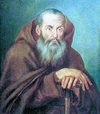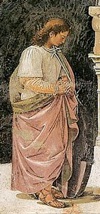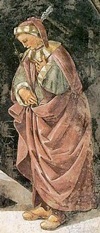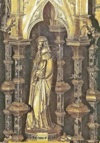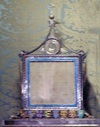

Saints
Blessed Ambrose of Massa (17th April)
Text
[Link to Blessed Ambrose of Massa]
St Crispin of Viterbo (23rd May)
Pietro Fioretti (1668 - 1750), who became a Capuchin lay brother in his native Viterbo, taking the name Crispino, was canonised in 1982. He lived at the Convento dei Cappuccini in Orvieto for some 40 years from 1709. He died in the Convento di Santa Maria della Concezione, Rome, and his tomb survives in a chapel of the church.
St Faustinus (29th July)
The relics of St Faustinus, who was martyred in Rome in the reign of the Emperor Diocletian, were translated to the Cappella Nuova of the Duomo in 1421. They subsequently saved the city from an outbreak of plague.
“St” Peter Parenzo (22nd May)
Peter Parenzo , whom Pope Innocent III sent to Orvieto as legate in 1199, was murdered there by heretics. He was buried in Santa Maria Prisca, and his relics were subsequently moved to the Cappella Nuova of the Duomo. He was never formaly canonised, but is revered in Orvieto as a saint.
St Sabinus of Canosa (9th February)
St Sabinus was the bishop of Canosa, Apulia in the 6th century. Bishop Angelarius rescued the relics of St Sabinus and took them to Bari when Canosa was destroyed by Saracens in in 844. It is not clear some of them came to be venerated in San Giovenale, Orvieto.
St Severus (1st October) and St Martirius (23rd January)
The Abbazia di SS Severo e Martirio outside Orvieto is dedicated to SS Severus and Martirius, who are mentioned in successive stories in the Dialogues of Pope Gregory I.
Blessed Jane (Vanna) of Orvieto (23rd July)
Jane (Giovanna, Vanna) of Orvieto was born in ca. 1264 at Carnaiola, a village outside Orvieto. She fled to Orvieto in ca. 1304 to avoid pressure to marry, and entered domestic service under a Dominican tertiary named Ghisla. She became renowned for her ecstatic meditations on the suffering of Christ and for her ability as a prophetess. She died in 1306, and her uncorrupt body was translated to San Domenico some 15 months later. Her cult was confirmed in 1754, and her relics were translated to her native Carnaiola in 2000.
Blessed Thomas of Orvieto (21st June)
The Blessed Thomas, who was born in Orvieto, became a lay associate of the friars of Santa Maria dei Servi in ca. 1285. He became known as “il frate del fico” (the brother of the fig) when he successfully prayed for figs in winter to satisfy the craving of a pregnant woman. His humility allowed him to perform other miracles, which continued after his death in 1343. His relics in Santa Maria dei Servi were recognised again in 1738, and Pope Clement XIII duly confirmed the cult in 1768. The relics were subsequently translated to the high altar of the church.
Relics
Sacro Corporale
The linen altar cloth that had been stained by the blood of Christ in 1264, during the Miracle of Bolsena, is preserved on the altar of theCappella del Corporale in the Duomo and taken in procession each year on the Feast of Corpus Christi.
